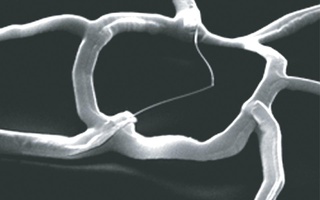These wires conduct electricity like normal wires but they can also be arranged so they act like mini-transistors, which are the smallest working unit of a computer.
The challenge is arranging these wires in a useful way. Manipulating a wire ten atoms across is itself a technical feat.
BF: When Tweezers Won't Cut It
The Lieber group has been able to control the arrangement of the wires on a surface using what the researchers call a "micro-fluidic channel."
Moving liquid in the groove of the channel aligns the ultra-small nanowires in the same direction.
"Take a river or fast moving stream; if you put logs in the river they line up," says Lieber.
Aligning nanowires is the first step in making electronic circuits that could be used in ultra-small computers.
In their February paper in Science, Lieber's group used nanowires to make basic electronic components. Now, he says, he has linked such units together-a discovery that provides a crucial first step towards building complex logical circuits, like microchips.
Read more in News
Council Supports Online Concentration GuideRecommended Articles
-
Women's Lacrosse Drops to TerriersThe end of Spring Break hits all Harvard students hard. Yesterday, the women's lacrosse team had its rude awakening. After
-
Chemistry Professor Garners Prize for Nanotech InnovationHyman Professor of Chemistry Charles M. Lieber recently received this year’s World Technology Award for Materials for his work in
-
Team Develops Nanowire RingsHarvard researchers have developed a breakthrough nanowire technology integrated into high-tech electronic circuits—which, among other things, could help manufacturers significantly
-
Research Assists Cancer TestsHarvard researchers have found new ways of assembling nanowires—ultra-thin wires that have the potential to revolutionize electronics—and a new application
-
Chemistry Researchers Bend NanowiresA group of researchers in the lab of chemistry professor Charles M. Lieber have found a way to synthesize two- and three-dimensional versions of the microscopic strands known as nanowires—a breakthrough that researchers say may greatly increase the reach and applicability of the field by allowing scientists to design vastly more complex structures.
-
 ‘Cyborg Tissue’ Created
‘Cyborg Tissue’ Created













